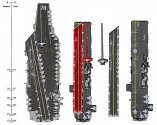Why bother with two EMCATs of significantly different lengths on just one ship?This is the way
I highly doubt that J-35s will operate from the 075-mod/076 LHDs.
Why bother with two EMCATs of significantly different lengths on just one ship?This is the way
Why bother with two EMCATs of significantly different lengths on just one ship?
I highly doubt that J-35s will operate from the 075-mod/076 LHDs.
Contingency-only I hope.The idea and expectation of 076 or any LHA to operate J-35 in a combat situation are all projecting US Marine operation onto PLAN. That I call a stretch of thinking. It isn't about technological choice or realization, it is docrine and politics.
Would it make a good case for emergency cases? For example, a carrier has been taken out of action/sunk, and there needs to be some aircraft around and fast. To the point quality matters little, any is better than none?Contingency-only I hope.
The logistics for basing both UAVs and J-35 would be a total nightmare. Extra pilots/command staff/mechanics billeting, different sets of spares, fuel, and weapons, etc...
075/076 are all Diesel so speed/acceleration limited.
LHA's operate much closer to the enemy shores so either air superiority is already established or coverage provided by other assets. A few J-35s can't do much.
Instead of a single Swiss knife, I rather have much better and dedicated tools (i. e. a System) and China can easily afford.
That is one of the contigency scenarios when a proper CV is always in the picture.Would it make a good case for emergency cases? For example, a carrier has been taken out of action/sunk, and there needs to be some aircraft around and fast. To the point quality matters little, any is better than none?
Does anyone know if we are looking at the top deck (weather deck) of the ship? It seems to me it is the top deck, and if it is there seems to be no room for EM cat due to the two big rectangular openings in the bow seciton.
You may as well make a 003 at this point.3. Shandong but improved and as CATOBAR CVs.
By now, we need to understand that the 075s and 075-mod/076s are LHDs from-the-keel-up. Their inherent hull design and engineering which allows them to perform their primary tasks (i.e. conducting and supporting amphibious assault operations) also means that they will never be able to sail as fast and with similar endurances as proper combatant warships, namely CVs, CGs, DDGs and FFGs.
This is why all LHDs and LHAs across the world can sail no faster than 24-25 knots at most.
Speaking of using 076 LHDs as "lightning carrier" of sorts - The information available to us at present does not support the operation of J-35s from said LHD, given the significantly shorter length of the 2x EMCATs on the 076 LHDs (~40 meters) compared to the 3x EMCATs on Fujian (~100 meters). At best, those shorter EMCATs can only launch UCAVs within the weight class of the GJ-11 (which, according to @万年炎帝 on Weibo,may actually approach that of the X-47B), at most.
In the meantime, if there is indeed an acute need to replenish carrier-based airpower ASAP in case of high tension or war - Personally, I am in favor of procuring the 21st-century version of Independence CVLs or Unryu CVs. TL; DR - Smaller, cheaper, easier to built and less complex flattops compared to their larger, proper CV counterparts.
Three options:
1. Recall that pop3 mentioned about Chengdu and Shenyang are currently developing S/VTOL warplanes (likely fighters), which has been noted as being fully independent of the J-35. If that is true, then an expanded variant of the Izumo as pure S/VTOL CVs; or
2. Repeated and improved variants of Shandong as STOBAR CVs; or
3. Shandong but improved and as CATOBAR CVs.
Note that option 1 does not permit AEW&C aircraft operations, option 2 may or may not permit AEW&C aircraft operations, while option 3 certainly permits AEW&C aircraft operations.

